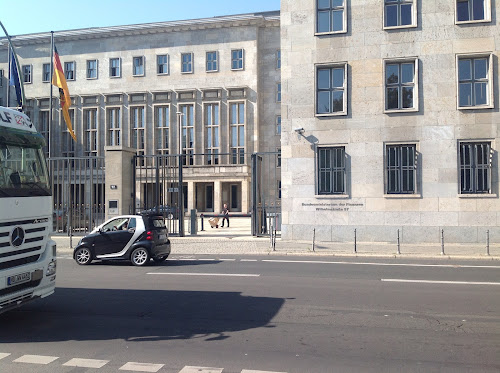Goethe Institut offers various programs through the week. Some are presentations by area professors, some are museum visits, and some are guided tours through certain parts of Berlin. So on Tuesday, September 11th, I went on a tour through the parts of Berlin that Hitler had changed during his rise to power. First, we stopped by the Brandenburg Gate. Here Hitler would show off his military strength to foreign dignitaries. The tour guide showed us the plans that Hitler had for the city. One only wonders how different the world could be, had Hitler gone into architecture and city planning instead of to war.
The American Embassy is right there by the Gate, and because it was September 11th, the flag was lowered to half-mast.
After that we visited the Holocaust Memorial. It's an abstract piece of art, with about 2000 coffin-shaped stones with varying heights and on varying grades. In fact, no stone is identical to another. It being abstract art, I suppose you can come to your own opinions about what that means. I don't particularly enjoy abstract art, but I got the feeling that this memorial was trying to give.
Not far away was the place of Hitler's bunker, though there is no sign to attract you to its existence. The tour guide showed us the parking lot under which it was located. Though most of the rooms have been destroyed by the attempts of the Soviets', and more have flooded, caved in, or filled with rock, I think there are still a few rooms that one could go through. I'm not sure though. In the picture below, the bright blue van in the background is where Hitler's body was burned.
Right by this parking lot is a typical East German apartment flat: very plain and made of concrete. As Keaton Christiansen noted, "the power of centralized bureaucracy... what wonders it hath wrought."
Next we stopped by the entrance to Hitler's Reich Chancellery. Interestingly, a Chinese restaurant is located there now. People who wanted to see Hitler had to walk 150m to his office, being surrounded by the best of German art and might on the way. No doubt this was to impress them, but I'm sure it was also a security measure for Hitler.
Then we saw the building that was built for the Ministry of Aviation (Luftwaft) in the 1930s. It's still intact, and the German Finance Ministry inhabits that place now. From what I gathered, the reason it didn't get bombed because it had a lot of anti-aircraft guns around it.
Finally, we walked to the Topography of Terror, which described the rising of the Nazi Party and the events surrounding WWII. Honestly, I couldn't take a lot of photos, because they just wouldn't do justice to the horror that was depicted. One picture in particular caught my eye, and I think you know why. It's of Bonhoeffer, because he was arrested and executed for being a part of a plot to kill Hitler. He spent a while in prison, from which he wrote many letters, but he was killed within days of Allied forces reaching his prison.









No comments:
Post a Comment